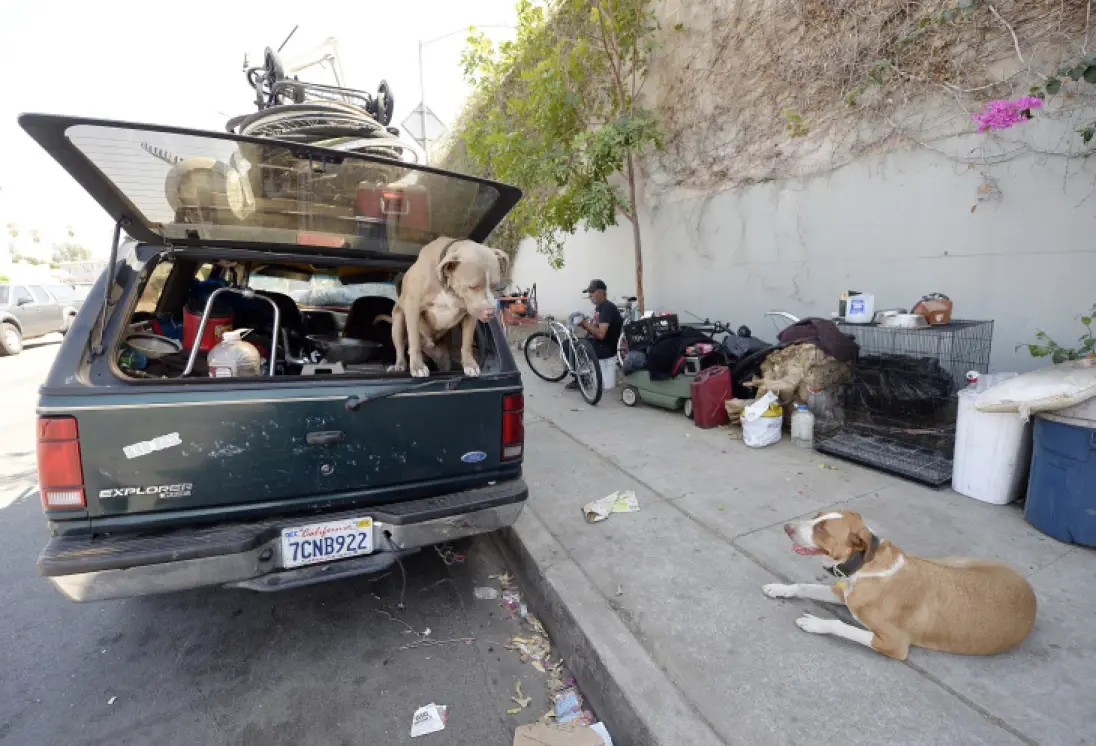In TV news segments and election season political ads, images of sprawling tent encampments have become the face of a worsening homelessness crisis in Los Angeles.
But tents did not play a significant role in the past year’s 9% rise in homelessness across L.A. County. In fact, the number of tents used as dwellings on L.A. streets fell slightly, from 4,304 in 2022 to 4,293 in 2023.
Instead, the increase reported in this year’s homeless count was disproportionately driven by people living in vehicles. The number of cars used as shelters rose 16%, and the number of vans skyrocketed 44%.
Unhoused people in L.A. County used more than 14,000 vehicles (including RVs) as dwellings according to the region’s 2023 count, compared with about 9,300 tents or makeshift shelters.
“It's not surprising that the population continues to grow, because we're just doing very little to address it,” said Madeline Brozen, deputy director of the UCLA Lewis Center for Regional Policy Studies and lead researcher on a project centered on vehicular homelessness in L.A. Vehicle dwellers hidden from view
Despite the fact that more Angelenos live in vehicles, local attention and political energy has been largely devoted to reducing tent encampments. In the last year, L.A. city councilmembers have expanded anti-camping ordinances. And L.A. Mayor Karen Bass’ Inside Safe initiative, launched shortly after she took office in December, has mainly focused on moving residents from tents into temporary motel rooms.
People living in vehicles receive less attention from policymakers, Brozen said, because they tend to be more hidden from public view than those pitching tents on sidewalks and hillsides.
Despite their absence from public discussions about homelessness, “people living in vehicles have been the majority of our homeless population for years,” Brozen said.
Brozen and her colleagues have found that the population of people living in vehicles across L.A. County differs from those living in tents. Women are more likely to live in cars, vans and RVs, and vehicle dwellers are often older, more likely to have children and more likely to be employed. They’re also less likely to be chronically homeless — many move straight into their car shortly after an eviction or job loss.
“If we look at just the increase in cars and vans, that suggests there's also an increase in people that are newly homeless,” Brozen said.
L.A. homelessness officials highlighted an 18% increase in people experiencing long-term, chronic homelessness in this year’s count. But Brozen suspects the end of COVID-19 eviction protections and pandemic relief efforts also pushed many people out of their apartments and into their cars. Number of RVs dips slightly
Recreational vehicles and camping trailers continue to provide shelter for thousands of Angelenos. The number of RVs tallied in this year’s homeless count fell by about 5%, from 7,178 in 2022 to 6,814 in 2023. But RV dwelling is still up 31% from 2020.
People living in vehicles are not as easy for homeless outreach workers to contact. Unlike tent encampments, where people experiencing homelessness cluster together, people living in cars and vans tend to spread out, often parking in places where they won’t attract attention.
HOMELESSNESS FAQ
How did we get here? Who’s in charge of what? And where can people get help?
Read answers to common questions around homelessness in the L.A. region.
Some programs tailored to vehicle dwellers have been piloted across L.A. County. The Los Angeles Homeless Services Authority funds 23 safe parking sites where people can sleep in their cars and have access to restrooms, case management and on-site security.
However, there are only a few hundred safe parking spots available to L.A.’s estimated 22,000 vehicle residents. And many safe parking sites don’t allow RVs.
As housing costs have soared across L.A., some property owners have turned to renting out yards and driveways. Late last week, the Los Angeles Times reported that an empty lot in Sylmar used as a makeshift RV park prompted the L.A. city attorney’s office to file misdemeanor charges against the owner. Photos of the property show over a dozen RVs parked back to back, inches apart. Policy discussions shift toward vehicle dwellers
During a press conference to announce the results of the annual homeless count, Bass acknowledged the city needs to do more to help people living in vehicles.
“We need to look at some things I'm not particularly fond of, things like safe parking for the RVs and the cars,” Bass said. “I say I'm not particularly fond of that because I want to move people into housing. But in the event that people, number one, don't consider themselves unhoused when they're in an RV, or they don't own that RV, maybe we can look at safe parking.”
RVs in particular have begun to attract more attention from voters and politicians. Growing RV encampments became a prominent issue in the recent L.A. city council District 6 race.
Westside city councilmember Traci Park introduced a motion earlier this year aimed at cracking down on “vanlords,” people who make money renting out RVs to unhoused people.
L.A. city controller Kenneth Mejia has criticized the city council’s approach to overnight parking bans, which prohibit parking from 2 a.m. to 6 a.m. in certain areas, and called for a comprehensive strategy to help people who live in vehicles.
“Without a city-wide plan for addressing vehicular homelessness, creating banishment zones only serves to shuffle people from place to place,” Mejia recently Tweeted.
